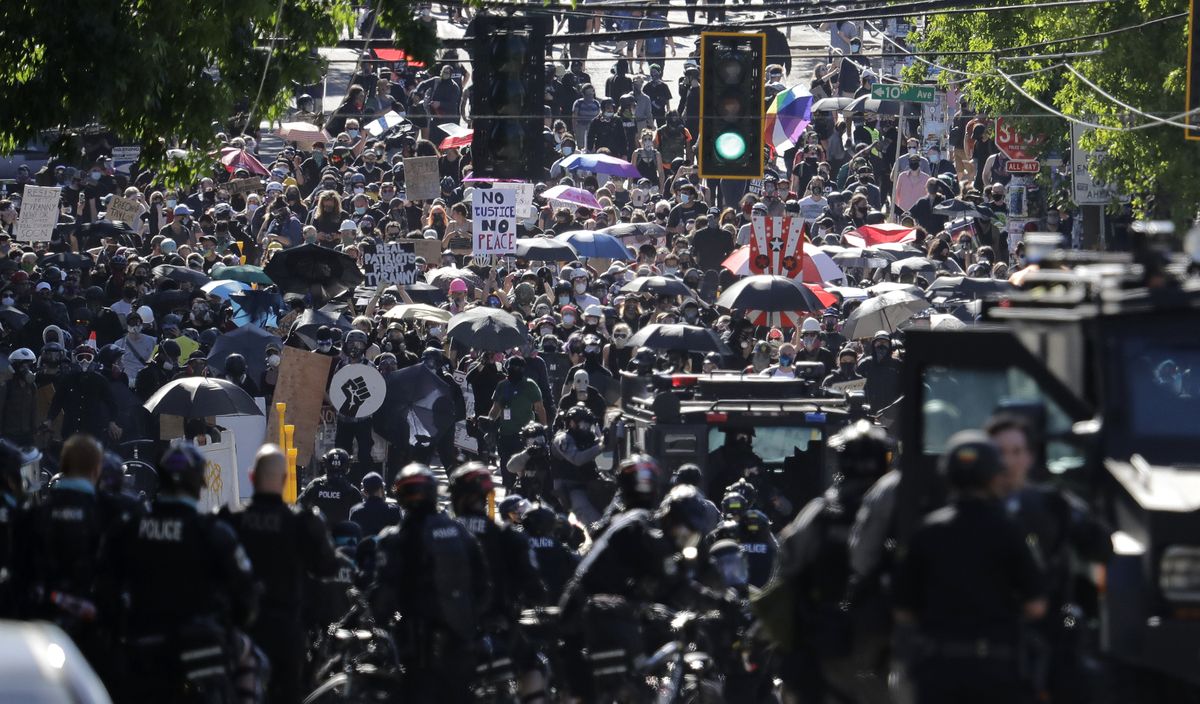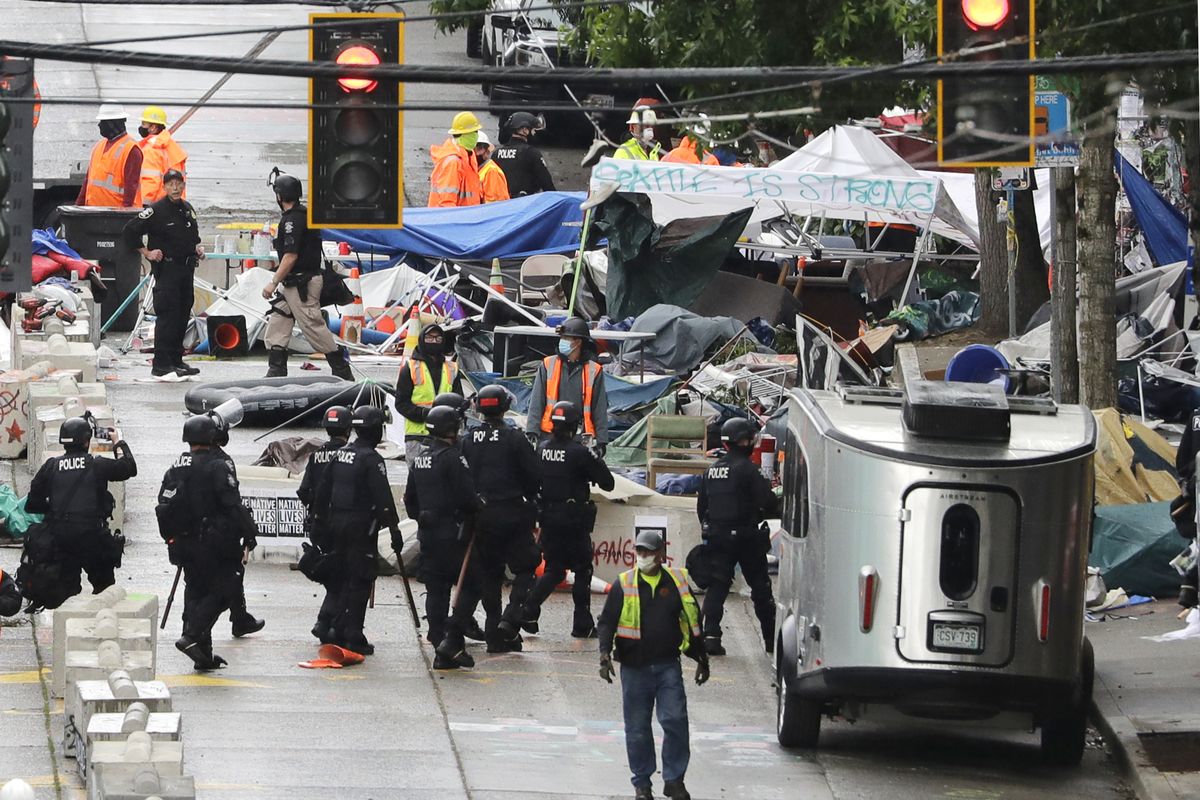On 150th day of Seattle protests, demonstrators say more work remains
Police clash with protesters on July 25 during a Black Lives Matter protest near the Seattle Police East Precinct headquarters in Seattle. (Ted S. Warren)
At a march on Monday night, protesters unfurled a banner at Westlake Park.
“Montgomery Bus Boycott: 381 days. Seattle BLM Protests: 150 days,” the banner read. “WE ARE JUST GETTING STARTED.”
The message was at the core of a demonstration Monday night to mark 150 days since protests for Black lives began in Seattle in the wake of the police killing of George Floyd in Minneapolis. Five months in, organizers and marchers say there is still much to do.
Like in cities across the United States, months of protests have kept pressure on Seattle City Hall. The Seattle City Council has already made some changes to the Seattle Police Department, despite objections from Mayor Jenny Durkan, and is considering more ways to shrink the department’s budget.
But reductions to the department have fallen short of protesters’ demands, and the number of people showing up to march and rally has waned. Though the crowd on Monday was in the hundreds, most protests have dwindled to around 50 people or fewer.
“One percent [in cuts to the department] is not what we demanded, so we’re not going to stop,” said Katie N., a leader of the Morning March, which gathers on weekday mornings. “The pressure needs to stay on in all lanes.”
Since police cleared an occupation near the East Precinct, smaller daily protests have continued throughout the city. Organizations and tactics have evolved.
Most of the groups march or block traffic. A group that often gathers on Capitol Hill has sometimes broken windows, spray-painted graffiti or set fires. A “car brigade” attempts to protect marchers from vehicle attacks.
Some of the protests have drawn criticism from those angered by property damage or road blockages.
The group that has vandalized businesses largely targets large corporations like Starbucks and banks, though smaller businesses have occasionally been damaged. During a small march in Bellevue on Saturday, the mayor declared a civil emergency for fear that demonstrators would destroy property. The night ultimately ended peacefully. Unlike many events in Seattle, that protest drew right-wing counterprotesters, livestreams showed.
A Crosscut/Elway poll of 400 registered voters in late September found 56% of people surveyed in Seattle said they support the protests and another 19% said they “mostly support” them. Support was slightly lower outside Seattle in King County. The same poll found that 67% of respondents in Seattle said they believed the protests had been mostly peaceful, while 27% said they were mostly violent. In King County outside Seattle, 49% said they were mostly peaceful and 40% said they were mostly violent.
While the crowds at current protests are smaller than they were in the summer, protesters’ demands remain familiar, most notably the call to cut the SPD budget by half and redirect that money to community groups.
“The big thing we’ve achieved is community, education and relearning anti-racism,” said Travonna Wiley with the Black Action Coalition, which leads marches on Fridays. Police budget cuts so far are “a fraction of a win” and should go further, Wiley said.
To keep the pressure on, “people have to be talking about this every day,” said Katie N.
Organizers on Monday told the crowd they were disappointed to see some people show up only on noteworthy days. “Y’all come out when it’s 150 days, but you weren’t out here for 150 days,” one organizer told the crowd.
“White supremacy is not a Black issue,” said Wiley in an interview. “We need white people here to fix this issue.”
As they marched from Capitol Hill toward SPD’s West Precinct on Monday night, marchers paused at Boren Avenue and Howell Street, where 10 years ago a Seattle police officer shot John T. Williams, a woodcarver and member of the Ditidaht First Nation. Later, during speeches at Westlake, speakers emphasized the continuation of a long struggle for civil rights. In some cases, their grandparents marched, too, one speaker said.
In the crowd stood Eagleson Williams, John T.’s nephew. “Nothing has been accomplished,” Williams said in an interview. “There needs to be more improvement, more steps to achieve what we’re searching for.”
There was little visible police presence for most of Monday night’s demonstration. Later in the night, a small group that had broken off from the larger group marched through Capitol Hill. When some in that group dragged recycling bins into the street and into the door of a building or parking garage on 12th Avenue, police descended and made arrests. It was not immediately clear how many people were arrested and for what.
Protests for racial justice have continued here since late May.
In early June, thousands demonstrated on Capitol Hill near the East Precinct and during other marches throughout the city. That month, police left the precinct and protesters occupied the area, which became known as the Capitol Hill Autonomous Zone (CHAZ) and then the Capitol Hill Organized Protest (CHOP). Seattle continues to face a lawsuit from business owners who say the city failed to police the area or protect them from property damage and threats during the occupation.
On June 7, a man drove his car into a protest near the East Precinct and shot and injured one person. In June, two young men, Lorenzo Anderson and Antonio Mays Jr., were killed and four other people were wounded in shootings in the occupied area. On July 1, police swept in and cleared the protest camp. At a July 4 protest on Interstate 5, a driver struck protesters, killing Summer Taylor and seriously injuring Diaz Love.
Anderson’s father filed wrongful-death claims against the city, county and state, and Taylor’s family is part of a lawsuit against the city and state.
The police response to protests continues to draw criticism.
Though police largely stopped using tear gas, officers continue to use pepper spray, blast balls and impact munitions at some protests. A City Council ordinance that would largely ban crowd-control weapons is still tied up in federal court. Officers have responded to some nighttime protests in large numbers on bikes and in vehicles, sometimes with sirens on, behind protesters.
The city’s civilian-led police accountability office has received thousands of complaints about police response to protests.
SPD has denounced property damage and injuries to officers at some demonstrations, including one nighttime protest in September where someone in the crowd was seen on video hitting an officer in the head with a baseball bat.
So far this year, 110 officers have left the department, most of them retirements by officers with more than 20 years of work or departures of officers with up to 10 years of service. In exit interviews, some said the current political atmosphere and protests were among the reasons for their departures. Officers who left in recent years, before the recent protests, also criticized city leadership in their exit interviews.
In the crowd Monday evening, protesters described feeling both energized by the demonstrations and disappointed politicians haven’t done more.
“Nobody has given this the attention it deserves, especially when it comes to defunding SPD,” said one protester, who declined to give a name.
Marissa Hackett, who lives on Capitol Hill near where many of the protests have started, said it was just her second time out this year. Sometimes she cheers the groups from her balcony, she said.
On Monday, “we wanted to show solidarity with those who’ve been out every day,” Hackett said. “[The protests] have forced a lot of conversations that would not have happened otherwise.”
Kaitlyn, a protester who was handing out kazoos from a paper bag and playing a ukulele, said she found it “demoralizing how little is being done by elected officials.”
Still, she said, “I don’t know what to do except come out here and add myself to the numbers.”

